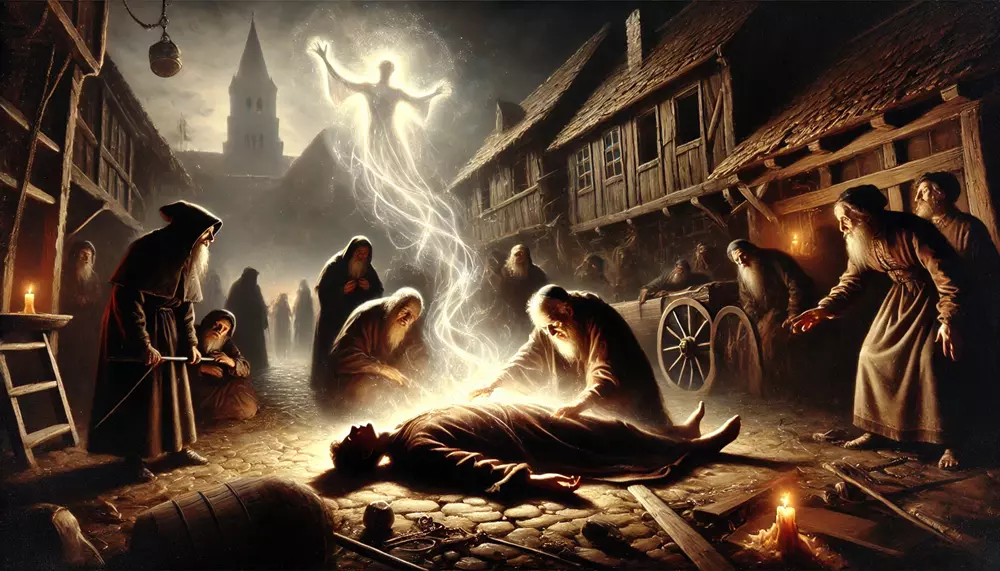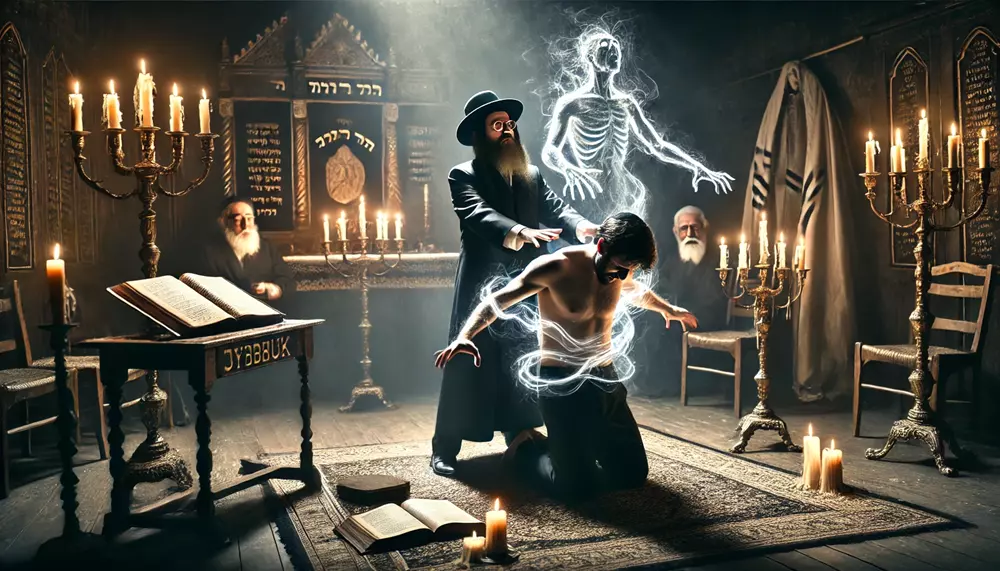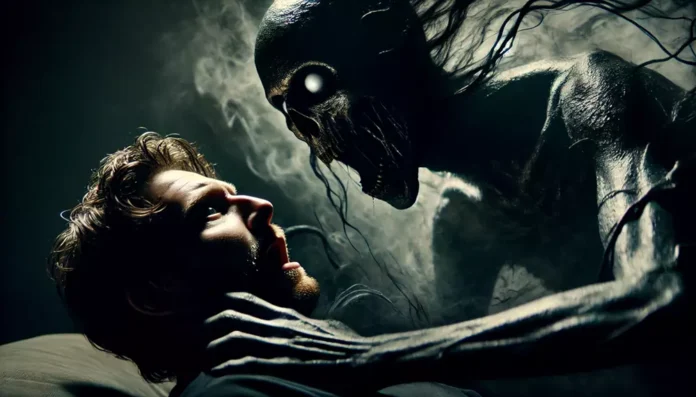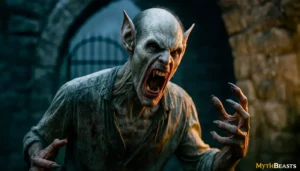Dybbuk: The Spirit That Lingers
The Dybbuk is a haunting figure in Jewish folklore, known for its ability to possess the living and disrupt their lives.
Originating in the Ashkenazi Jewish tradition, the Dybbuk is considered a restless spirit, one unable to move on after death. Tales of Dybbukim, as they are collectively called, blend fear, spirituality, and the human need for closure with the afterlife.
This folklore has survived through the centuries, moving from oral traditions to the pages of literature and film, capturing the imagination with its chilling depiction of possession and exorcism.
Origins and Mythological Background
The concept of the Dybbuk first appears prominently in Jewish mystical texts from the 16th century, particularly those tied to Kabbalistic traditions. However, the belief in wandering spirits that can inhabit the bodies of the living has ancient roots, even preceding the notion of the Dybbuk as known today.
Jewish Mysticism and Kabbalah
The Dybbuk is deeply connected to Kabbalah, a form of Jewish mysticism that explores the nature of God and the universe. According to Kabbalistic beliefs, souls that have sinned or failed to fulfill their divine purpose can become trapped between worlds.
These souls may become Dybbukim, attaching themselves to the bodies of the living to find closure, complete unfinished tasks, or seek revenge. This process is seen as a form of tikkun, or repair, which is central to Kabbalistic teachings.
In this sense, the Dybbuk is not merely a malicious entity but one that seeks resolution.
The term “Dybbuk” comes from the Hebrew word dāḇaq, meaning “to cling” or “to adhere,” reflecting the spirit’s tendency to latch onto the living. The idea of possession by such spirits was a way to explain various mental and physical illnesses, which were seen as manifestations of spiritual imbalance.

Early Folktales and Depictions
In Ashkenazi Jewish communities of Eastern Europe, stories of Dybbuk possession became widespread during the Renaissance period. These tales often involved individuals who had violated religious or social norms, resulting in a Dybbuk attaching itself to them as punishment or retribution.
The possessed individual would display strange behavior, speak in languages unknown to them, or exhibit physical ailments. Communities would often turn to rabbis and religious leaders for exorcism rituals to expel the spirit and restore the person to health.
Cultural Impact and Evolution
The Dybbuk holds a unique place in Jewish culture, embodying the fears, anxieties, and spiritual beliefs of Ashkenazi communities. The belief in Dybbukim provided a framework for understanding misfortune, illness, and the moral repercussions of one’s actions.
The Role in Jewish Society
For centuries, the fear of Dybbuk possession influenced Jewish societal norms and values. The Dybbuk was often seen as a cautionary figure, a reminder of the consequences of sin and the importance of adhering to religious laws.
It was also a source of comfort, as belief in the Dybbuk allowed communities to address grief and the unexplained through spiritual means.
Families who experienced possession often sought out prominent rabbis for help, giving rise to the practice of exorcisms, which were seen as both a religious duty and a communal event.
Exorcisms were intricate rituals involving specific prayers, the blowing of the shofar (a ram’s horn), and often required the guidance of a learned Kabbalist.
Literary and Artistic Representations
The Dybbuk became an enduring theme in Jewish literature and theater, particularly in the early 20th century. S Ansky’s play
The Dybbuk, written in 1914, remains one of the most famous depictions.
Ansky’s play tells the tragic love story of a young bride possessed by the spirit of her deceased lover. The play has been translated into numerous languages and adapted into films and operas, solidifying the Dybbuk’s place in modern culture.
Ansky’s work explores themes of love, faith, and redemption, and underscores the Dybbuk’s connection to the Jewish experience, as it touches on issues of arranged marriage, forbidden love, and the consequences of breaking religious taboos.
Symbolism and Archetypes
The Dybbuk serves as a potent symbol of unfinished business, unresolved guilt, and the longing for atonement. It embodies the notion that our actions have consequences that can reverberate beyond the grave.
The Dybbuk also reflects the dual nature of spirits in Jewish folklore: they can be both terrifying and pitiable, driven by human emotions and seeking closure just as much as they inflict suffering.

The Dybbuk as a Shadow of the Past
In psychological terms, the Dybbuk can be seen as an archetype of the “shadow self” – aspects of the personality that are repressed or denied. The possession by a Dybbuk represents the return of these suppressed elements, demanding attention and resolution.
This archetype is particularly resonant within Jewish culture, which has faced centuries of displacement and persecution, as it symbolizes the haunting power of memory and unresolved trauma.
Similar Beasts
The Dybbuk has many mythological cousins across cultures, beings that represent possession, spiritual unrest, or ghostly vengeance.
Oni (Japan)
These demonic spirits are staples of Japanese folklore. Though usually not possessive like the Dybbuk, Oni are often malevolent and drawn to human suffering.
In some Noh plays, Oni can embody wrathful spirits of the dead, just like Dybbuks haunt the living out of unresolved pain.
La Llorona (Latin America)
This wailing ghost seeks children to replace her own, whom she drowned in a fit of grief.
Like the Dybbuk, she is a restless soul tied to a tragic past and is feared for her eerie cries and her ability to curse those who encounter her.
Vetala (India)
From Hindu lore, Vetalas are spirits that inhabit corpses. They often control the dead body they possess, much like Dybbuks possess the living.
They can also speak riddles and predict the future, making them both feared and respected.
Myling (Scandinavia)
These are the ghosts of unbaptized children who haunt the living, often riding on their backs until the person collapses. The burden metaphor matches the emotional and spiritual weight Dybbuks often symbolize in Jewish narratives.
Mare (Germanic folklore)
A more abstract comparison, the Mare is a spirit that causes sleep paralysis and nightmares.
Though not a ghost of a dead person, it represents an invisible force that invades human experience, similar to how a Dybbuk subtly takes hold of the possessed.
These beings all echo the Dybbuk’s core themes: unresolved trauma, possession, and the blurred line between life and death.
Modern Representations in Popular Culture
In modern times, the Dybbuk has transcended its roots in Jewish folklore to become a widely recognized figure in horror and supernatural genres. The concept of spirit possession, with roots in the Dybbuk tradition, has influenced how exorcism and paranormal phenomena are depicted in popular culture.
Film and Television
The Dybbuk appears in various films, both directly and indirectly. Notable adaptations of Ansky’s play include the 1937 Yiddish film The Dybbuk, which remains a classic of Jewish cinema.
More recently, the Dybbuk was featured in movies like The Unborn (2009), which brings the myth into a contemporary setting, and The Possession (2012), which revolves around a cursed Dybbuk box containing a malevolent spirit. These portrayals often emphasize the horror elements of the Dybbuk, with special effects and suspenseful storytelling to heighten the fear factor.
Literature and Theater
The Dybbuk continues to inspire writers and playwrights who explore themes of love, death, and the supernatural. In contemporary literature, authors often reinterpret the Dybbuk as a metaphor for emotional or psychological struggles.
This is particularly evident in works that address intergenerational trauma, as the Dybbuk symbolizes the lingering impact of past events on the present.
Video Games and Other Media
The Dybbuk has even made appearances in video games and other forms of media. In these portrayals, the Dybbuk is often depicted as a powerful antagonist, using its ability to possess and manipulate others as a means of advancing the plot.
Games and graphic novels that delve into supernatural themes frequently draw on the Dybbuk legend for its potent mix of horror and psychological complexity.
Conclusion
The Dybbuk is a haunting reminder of the power of the past to shape the present. As a figure of fear, remorse, and the desire for redemption, the Dybbuk embodies both the terror of possession and the hope for spiritual healing.
In each telling, the Dybbuk’s story reflects the enduring human need to reconcile with the unresolved and the unknown. Through folklore, literature, and popular culture, the Dybbuk continues to captivate and unsettle, remaining a powerful symbol of the ties that bind us to the spiritual and cultural legacies of our ancestors.








